The CMIP6 multi-model ensemble is a unique resource with input from scientists and modeling groups from around the world. [CMIP stands for the Coupled Model Intercomparison Project, and it is now in its 6th Phase]. But as we’ve discussed before (#NotAllModels) there are some specific issues that require users to be cautious in making predictions. Fortunately, there are useful ‘best practices’ that can help avoid the worst pitfalls.
A new paper by McCrystall et al that has just appeared in Nature Communications illustrates these issues clearly by having some excellent analyses of the changes in Arctic precipitation regimes at different global warming levels, and examining the sensitivity of their metrics to both local and Arctic warming, but unfortunately relying on the CMIP6 multi-model mean for their headline statements and press release.
The problem with the CMIP6 ensemble
Any use of CMIP future projections (either in CMIP6 or previously) requires some idea of what the scenarios represent (plausible storylines) of course, but in CMIP6 there is the (somewhat awkward) spread in climate sensitivities that is both greater than in previous CMIP iterations and also extends beyond the values constrained by multiple observations.
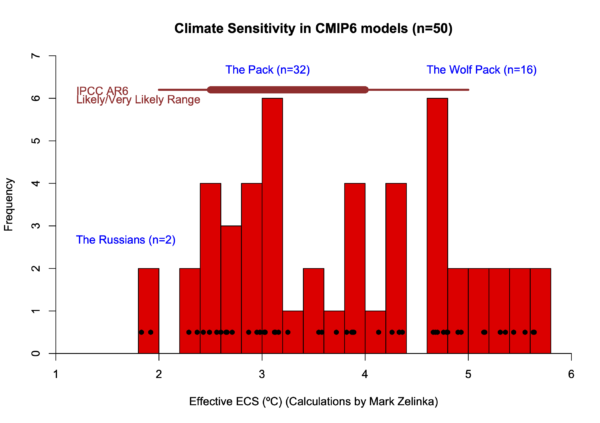
There are notably eight models that have climate sensitivities greater than 5ºC (and more than a dozen greater than 4.5ºC) (and for fairness, two models with ECS under 2ºC). This is sufficient to skew the multi-model mean of the global mean surface temperature higher than the assessed projections seen in the latest IPCC report (Chapter 4).
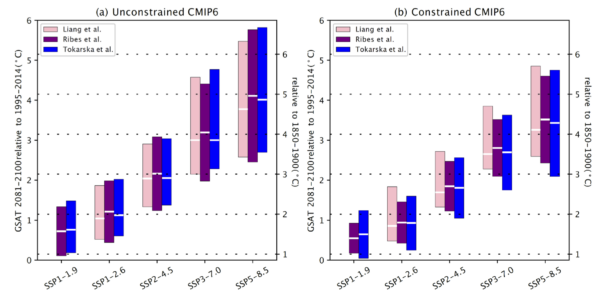
This was not the case for CMIP5. There, the spread of the models was similar to the constrained limits, and the multi-model mean was very close to the assessed projections, and so it was used widely (even by us) as a best guess. The bottom line is that for CMIP6 the multi-model mean is not the same as the expected prediction.
What difference does CMIP6 make for Arctic precipitation?
McCrystall et al do a lot of work in their paper that is great and appropriate. They look at the impacts at specific Global Warming Levels (GWLs):
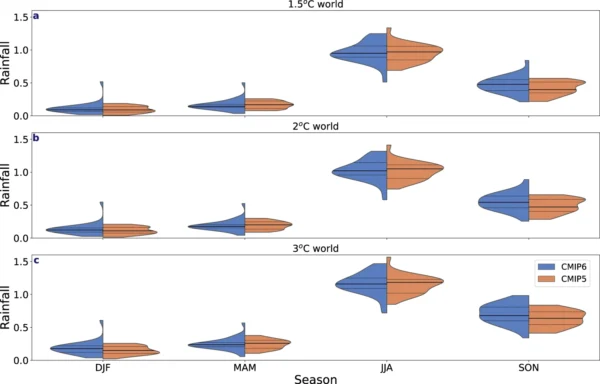
and in more detail at the sensitivity of the precipitation change per degree over the year:
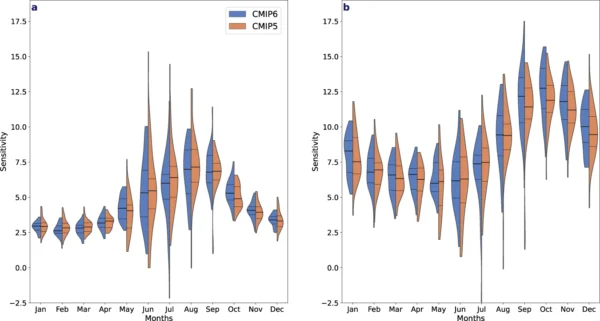
Both of these analyses incorporate all the models but don’t explicitly depend on the overall climate sensitivity. While there are some differences between the CMIP5 and CMIP6 models (particularly at the tails), the means are pretty close. That is, once you abstract out the global or Arctic level of warming, there isn’t that much difference between the projections from the CMIP5 or CMIP6 models (one could test that more formally of course).
There is a slightly clearer difference in their fig. 5 in the SON period where the sensitivity of precipitation to the open water amount seems stronger in CMIP6 than in CMIP5, but mostly everywhere else the sensitivities seem comparable (even though the magnitude of change in some of the CMIP6 models is much larger). So far so good.
However, the main conclusion that the authors highlight in the press release and which was picked up in the newspaper coverage was the claim that rain would dominate Arctic precipitation ‘decades earlier’ than previously thought. This is based on the last row of figure 8:
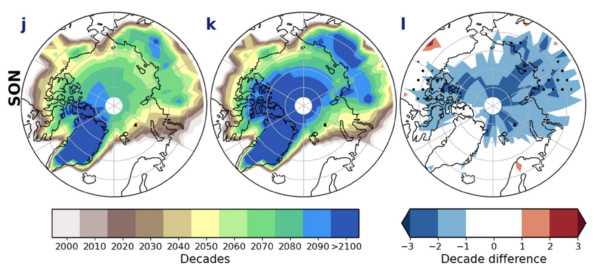
This shows the results from the raw ensemble means, and uses the absolute times in the output. Given the excessive warming in some models, which will have an earlier transition than the other CMIP6 or CMIP5 models, this result is mostly due to the inclusion of the high ECS models, not anything fundamental about the processes involved. There is some evidence of differences in this metric in the GWL diagnostics, but the signal is much smaller than in fig 8. Ideally, one might like to compare this result to the constrained subset of the CMIP6 models that were used in the IPCC AR6 Fig. 4.11 or those that match the constrained ECS values, to disentangle the impact of (presumably) better process modeling in CMIP6 from the impact of a wider spread in ECS. However, that is not (yet) possible (since what was done is not yet clear). So, unfortunately, we have a widely telegraphed conclusion that purports to be because of some advances in the science, but mostly relies on the excessive and unrealistic ECS in some of the models used.
Lessons to be learned
As I stated when the IPCC report came out, the CMIP6 ensemble has killed the notion of model democracy (‘one model, one vote’). It wasn’t really strictly correct in CMIP5 or previously, but it was close enough to serve as a useful heuristic. This is no longer the case in CMIP6. The default behavior in the community has to move away from considering the raw model ensemble mean as meaningful. The analyses that make sense are the impacts related to GWL, the sensitivity of any impact to the global mean, and various flavours of weighted or subsetted means that would allow the impacts to be coherent with the assessed projections of global mean temperature from AR6.
Providing these recipes to the broader community should be a high priority for the CMIP community or for any projects that are using the CMIP6 data as input.
References
- M.R. McCrystall, J. Stroeve, M. Serreze, B.C. Forbes, and J.A. Screen, "New climate models reveal faster and larger increases in Arctic precipitation than previously projected", Nature Communications, vol. 12, 2021. http://dx.doi.org/10.1038/s41467-021-27031-y
 It’s almost routine by now: Every summer, many of those interested in climate change check again and again the latest data on sea-ice evolution in the Arctic. Such data are for example available on a daily basis from the
It’s almost routine by now: Every summer, many of those interested in climate change check again and again the latest data on sea-ice evolution in the Arctic. Such data are for example available on a daily basis from the